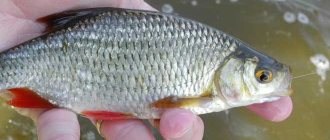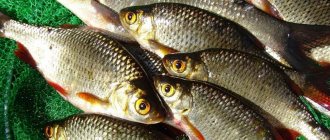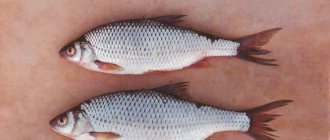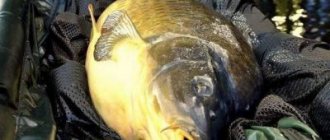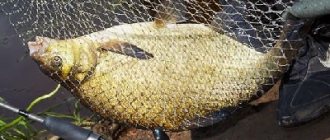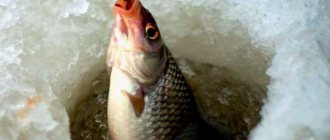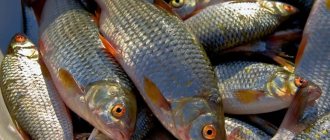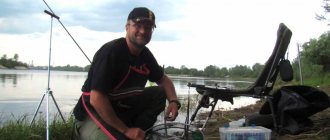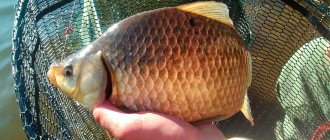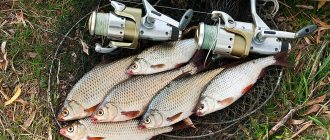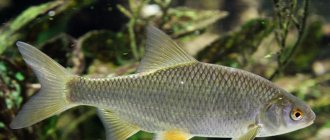Roach is the most common fish in most water bodies, but the bulk of this fish is caught in open water in spring and autumn. Roaches are also purposefully caught in the summer, but, as a rule, these are floaters. And what about the “donochniks”? They are aimed at a completely different catch and do not consider roach as an object of bottom fishing. It's a pity. There are too many interesting and exciting things in this activity.
Where to find roach
In summer, it is better to catch roach with a donkey on the river, where the roach is tastier (it doesn’t gorge itself on grass like on lakes) and takes a lot more. When on the river there is a temporary lack of biting for bream, ide, chub, and for the most part only small silver bream and bleak are biting, then bottom fishing for small roach is the best way out of the situation for an avid beaver. But to successfully catch roach on a donk, you will have to tune in specifically to this fish, choosing the necessary tackle and bait.
Catching roach with bottom tackle in spring
Home > Spring fishing > Catching roach with bottom tackle in spring
Catching roach with bottom gear in the spring is especially effective during the period of blooming water. This time is characterized by oxygen starvation of the fish, which tries to go to depth, which makes it possible to catch roach in the spring, like other fish, using donks or half-bottoms. The weight of the roach is determined by the fishing pond. There are lakes and rivers where it is almost impossible to find large roaches. But, generally, in the reservoirs of Central Russia, the weight of roach is often more than three hundred grams.
When fishing for roach in the spring, it is important for the angler to be able to find the location of the roach in the reservoir. Large roaches usually gather in small schools and try to stay in secluded places. In such conditions it is very difficult to catch roach with a float rod. A more effective way to catch roach in the spring is to fish with a bottom.
Large roaches often prefer to be located on river reaches with a rocky clay bottom and a small amount of silt. And, in addition, roaches often take refuge in holes located in slow or medium flow close to the edges. In summer, roaches of medium and small sizes feed on insects, worms, algae, and for larger roaches, in addition to such food, zebra mussels are a good food. Sometimes roaches attack fry.
Any angler can make a regular half-bottom for roach fishing in the spring on his own. When catching roach with a half-bottom, you need to take into account that thinner tackle increases the chances of successful fishing. For such fishing, anglers usually use a rod with a length of five to seven meters, which can be made of fiberglass or carbon fiber.
After the opening of the river, the time comes for more intensive feeding of the roach. It is during this period that fishing for roach can be effective close to the shore. But when fishing for roach in this way, it is necessary to take into account the especially careful behavior of roach in the spring. After the angler catches only one roach, the whole school usually moves away. And you can keep a timid flock with the help of dosed bait.
When fishing for roach in the spring, experienced fishermen use as bait a mayfly larva - “granny”, an amphipod and a dragonfly larva, which constantly live in the reservoir and are a common food for fish. Anglers usually scoop clay from the bottom with a long pole scoop and scoop up mayflies or look for crustaceans under rocks in the water. And dragonfly larvae can be found in the roots and stems of algae.
When fishing for roach in the spring, some fishermen use two larvae or crustaceans for bait to improve the bite of large fish. You can also use the most common baits - a bunch of small underleaf worms or maggots, a bunch of bloodworms. As a rule, when fishing for roach in the spring, the fish can find itself immediately after the angler casts the gear. Roaches usually make very greedy bites. The angler's readiness to confidently hook is essential for the success of roach fishing in the spring.
Fishing for roach in the spring usually gives good results. But you can catch roach on a half-bottom with no less success in the summer. Fishing for roach using a half-bottom has the advantage that it is possible to simultaneously use two or three gears in the presence of a fast current at the fishing site. When fishing this way, the bait is held well in one place with the help of a heavy sinker. And, for example, when fishing for roach with a regular fishing rod, the bait in such conditions is constantly being carried away.
Roach fishing tackle, hooks
There is a widespread opinion that saving on hooks costs more. And indeed it is. The normal performance of a good bottom roach hook is: one bite – one fish in the cage. However, to be more objective, for every ten bites there should be nine fish in the cage.
If a significant number of roach bites are not realized, especially if failures are common during fishing, then this hook is not suitable for roach.
Choosing a roach hook can begin with choosing the optimal shape. The shape of the hook should be well suited mainly for vegetable attachments (various doughs, star pasta, etc.). The size of the hook depends on the size of the bait, the size of the fish being caught and partly on the type of bait. And in each specific case you will have to select the optimal hook size. Moreover, the difference in rooms can be significant: from N18 to N8. If you take a hook smaller than what is required today, then when hooking it will often jump out of the fish’s mouth; if larger, then the percentage of empty bites will increase. To some extent, N10 can be considered a universal number on the river, but this is for heavy roach. For roaches weighing up to 150 grams, N12-14 is better, and with small baits, smaller hooks N16-18. When catching large roach on the bottom is greatly hampered by bleak and small silver bream, the N8 hook can help out, on which the roach sits quite normally.
How to install a winter donk with your own hands
The most famous and popular donkey equipment for winter fishing is called a “load” and its assembly takes from 5 to 10 minutes. Usually fishermen knit rigs at home, in comfortable conditions, but if a jig or hook breaks during fishing, restoring the functionality of the gear is not at all difficult.
In order to mount a winter donk “truck” you will need:
- winter fishing rod with reel;
- nod;
- sliding weight;
- float stops;
- 2 jigs;
- monofilament line with a diameter of 0.2 mm.
Instead of jigs, small hooks for bloodworms or maggots are used, it all depends on the fishing tactics chosen by the fisherman and the expected trophies. Some fishermen use a self-hooking hook on the bottom for winter fishing, which guarantees that after a bite the fish will be hooked. The use of self-hooking hooks is the choice of every angler and it all depends only on one’s own preferences.
The procedure for installing the “truck” bottom:
- Wind the line onto the reel.
- Attach a nod to the fishing rod.
- Thread the fishing line through the rings and pull it through the nod.
- At a distance of 20–30 cm from the end of the fishing line, make a branch for the upper jig 7–10 cm long;
- Place a stopper on the line and stretch it all the way to the outlet.
- Place a weight on the fishing line.
- Place another stopper so that the distance between them is 15 cm.
- Tie a jig to the end of the fishing line.
- Tie the second jig to the outlet.
The advantages of a “truck” winter fishing rod are that the jigs are located at a distance of 23–25 cm from each other and one moves along the bottom, and the second floats in the water column. This increases the likelihood of a bite, which means the catch will be larger.
It is better to fish with “trucks” in the current, then both jigs move in the water column parallel to each other. A sliding weight presses the tackle to the bottom, but at the first moment after the fish bites, it does not create obstacles and does not frighten it.
After pulling the jig, the fish is hooked under the weight of the load, even if self-hookers are not used. The “truck” is not only a simple, but also a catchy equipment, characterized by high sensitivity, which is important when catching inactive fish.
Jigs are preferable to hooks in that they are used both with and without baits, and it is easier to determine the preferences of the fish at a given time and in a given place.
There are jigs:
- light-accumulating;
- reflective.
Light-accumulating jigs are best used when fishing at night because their glow attracts fish. Reflective baits are more catchy in daylight. When choosing the colors of jigs, the angler is guided by his preferences and information about which baits work best in a given body of water.
Instead of monofilament, fishermen use fluorocarbon fishing lines as a base, which, although more expensive, have advantages. Fluorocarbon is hardly noticeable in water, it is a hard and frost-resistant material, so it is considered the most suitable for winter fishing.
Important! When installing the “Truck”, it is better to use a sliding sinker in the shape of an olive, streamlined shape.
Winter donka without a fishing rod
A fishing rod with a nod for winter fishing is necessary in order to see the lightest fish bites. When fishing for bream or perch, use a winter donka without a crow tail fishing rod. The advantage of this donkey is that when fishing with 5-7 rigs, the angler does not have to constantly monitor the position of the tackle; the fish are caught under the weight of the load.
Having prepared the required number of holes, the fisherman lowers the equipment on a reel into the water and when bitten, it turns over vertically, somewhat reminiscent of a crow’s tail. The reel should be dark in color to contrast with the snow and ice and its position should be visible from a great distance.
When installing the reel in a hole, a wooden strip 10–15 cm long longer than the width of the hole is threaded under the main fishing line wound around it. It turns out that the wooden plank is placed across the hole and the hooked fish will not drag the tackle into the water. The reel is located parallel to the ice, and after a bite, under the pressure of the fish, it turns over 90 degrees.
The work of the “crow’s tail” is somewhat reminiscent of the work of a girder, only there, after a bite, the flag becomes vertical, and in this case the reel. The tackle is very simple and catchy, not only for bream, but also for roach, bluegill and other white fish.
When making it, first of all you need to prepare the reels and they are cut out of dense dark plastic or bought at a fishing store. For ease of assembly and fastening of hooks, a piece of foam rubber or rubber insulation for windows and doors is glued to the reel.
The sizes of the hooks depend on the size of the baits used, and the length of the leader varies depending on the strength of the current. The stronger the current, the longer the leash is placed on the bottom, and after casting the tackle it will spread parallel to the bottom. The main line is monofilament or fluorocarbon, it all depends on the preferences of the fisherman and his financial capabilities.
A sliding sinker for donkey can be easily smelted at home using lead insulation or plates from batteries. The weight of the load also depends on the strength of the current, and ranges from 30 to 100–120 grams.
To install the donkey you will need:
- prepared reel with fastenings for hooks;
- sliding weight 30–120 grams;
- float stop;
- triple swivel;
- two leashes with hooks on a fishing line with a diameter of 0.14-0.18 mm;
- The main line is 10–15 meters long, 0.2 mm in diameter.
A triple swivel can be replaced with a wire rocker, but this makes the tackle rougher, which is best avoided.
We mount the donk:
- Wind the main line onto the reel, tying the end tightly.
- Place a sliding weight on the free end.
- Install the float stopper.
- Attach a triple swivel and lower the stopper to it.
- Attach leashes with hooks to the swivel ears.
The weight moves freely along the fishing line, and the float stopper protects the knot with which the swivel is tied from impacts when biting and lowering the tackle into the hole. The length of the main line depends on the depth at the fishing spot, because there must also be a reserve for comfortable landing of fish.
Biting a heavy trophy will require additional meters of fishing line, so the angler must be fully prepared, as well as his tackle.
The design of the winter donkey on a reel is reminiscent of the summer version of the bottom tackle, but the length of the leashes in it is longer, because the tackle is lowered into the hole, and not thrown by hand at 30–40 meters, which is inconvenient to do with long leashes.
Important! When fishing in winter, you need to have a supply of weights of different weights, especially when fishing in currents, which can become stronger.
Leash
Roach leash. Fishing experience confirms that the low efficiency of bottom fishing as such and roach fishing in particular often depends on a neglectful attitude towards such an important element of equipment as a leash. There are two points here: the length and thickness of the leash, and both most directly affect the results of catching roach. Of course, you can choose a universal leash length for yourself, say 40cm, and catch different fish. But if you aim at roach, then the length of the roach river leash fluctuates around 60-130cm. And the fact that somewhere someone successfully catches bream or carp with a 5cm leash should not confuse the roach fisherman. There may be several reasons for the effectiveness of long leashes. Here there is also a frequent fear of large roaches from feeders, to which the fish does not come close, but collects only washed food; and even the deterrent effect of bottom sinkers painted to match the color of the bottom; and more natural behavior of the bait on the hook. Moreover, it does not matter whether all three factors work in favor of a long leash or just one. In any case, with a long leash, catching roach on a donk is much more realistic.
Fishing with winter donks - sharing our experience
By the time the ice on the river becomes thick enough for safe movement, many fishermen are already having a blast on lakes and backwaters, fishing with jigs or girders. But as soon as the river is forged with a strong ice shell, you can get river winter donkeys.
Donka in winter - simple but effective tackle
I try to bring fishing equipment to maximum simplicity with minimal loss of efficiency and reliability. On light wooden reels 25 cm long I wind 15-20 meters of soft fishing line with a diameter of 0.23-0.25 mm green.
A sliding asymmetrical (with less twists) sinker of a rectangular or triangular shape and weighing 30-40 g is fixed on the fishing line as follows: first, the main sinker is put on the fishing line, then a cambric of such a length that its ends protrude from the slot of the shot by 1-2 mm. I insert the cambric with fishing line into the slot of the pellet and clamp it. With this method, the fishing line is practically not damaged, even if you have to move the pellet.
I tie the hooks to the main fishing line. I don’t use leashes - there are fewer knots and loops on which all sorts of algae and grass try to hang. If the hook breaks, I simply move the pellet up the line and tie a new hook. The distance from the hook to the shot is 20-30 cm, the sliding sinker moves freely along the main line.
In addition, thanks to the pellet with a cambric, you can change the distance from the hook to the sinker very quickly and simply - you just need to move the pellet, and while in the cold you tie a leash of the required length...
And one more convenient thing. On the reels, a nail bent into a half ring is driven into the side in the middle. When the tackle is lowered into the hole, the fishing line is inserted into this semi-ring, and the bottom is placed on the hole. Now the fish won’t drag it away, and no one will accidentally knock it over with their foot.
Bottom mousetrap - winter donk with a self-cutter
At the suggestion of my friend and companion, I sometimes use mousetraps on the ice. They gave this name to the gear after one fishing trip, when one such “mousetrap” completely caught all my donks. It worked (in principle, it is an ordinary donkey with a self-cutter) with the characteristic sound of a classic mousetrap slamming shut. With the difference that instead of a mouse (pah-pah) there were well-fed noses on the hook.
The main objects of hunting for donkey in winter
The main types of fish that I hunt with donkeys in winter are: nosefish, silver bream, roach and burbot, less often - bream and bream. The most remarkable thing is that the silver bream and the large nose bream stick to almost the same places in winter. For example, in a particular place, the silver bream is good, but the nosy fish is found only rarely. You move 30-40 meters upstream, and here the nosefish is already in full swing, but the silver bream is weak. And in the first and second places at night, burbot operates. But the roach can fly in anywhere; bluegill and podrus are often found.
See also: What to do when small fish prevent you from catching large ones
Calculate location
Knowledge of the topography and composition of the bottom at the site of bottom fishing is the key to successful fishing.
My favorite place has an ideal bottom topography: after a long sandy shallow water there is a bottom strewn with holes and mounds, various grooves. There is little algae, the sandy bottom predominates - large nosefish likes to stay here. Then, near the left bank, at the mouth of the stream, a gorgeous hole begins, snagged in the upper quarter.
The exit from the pit smoothly turns into a flat table with a slope to the left bank, then the pit begins again. And on this table between the pits there are good fish biting perfectly. Gustera is mainly in the lower part, closer to the entrance to the second pit, and the nosar is higher, near the exit from the first pit. Roach is caught both here and there, but the bream is caught mainly in the very depths and on the gentle slope of the table towards the left bank. Fish also bite in the pits themselves, but less often.
Night bites
A decent nosefish often begins to peck already in the dark, often getting caught along with burbot. An even, stable bite continues until 10-11 am. Then only single catches are observed. White bream (like roach) bites from dawn until sunset, with short breaks, enough to warm up by the fire and have a little refreshment with fried lard with garlic or onions.
The discovered school of fish seems to be walking in circles at the fishing point. Either there is a crazy bite, just have time to bait the worms, then only one or two heads in half an hour. In severe snowstorms and frost, the bite noticeably worsens, as does when the water level under the ice drops.
Baits
For bait I use small white or red worms. White fish take a little worse on an ordinary dung beetle, but a nosy fish doesn’t care what’s on the hook - it takes well on dead, frozen worms.
Lure
I rarely use complementary foods. Sometimes I just throw a handful or two of granulated feed into the hole above the fishing spot. Before fishing at home, I check in a glass of cold water how long it will take for the dense granules to disintegrate - the faster the better. Denser granules can be carried away by the current further than the place where baited hooks lie on the bottom.
Correct tactics – good catch
In the evening I plan what kind of fish I will catch. If it’s nosy, then I go out after dark. If to the bream, then before dawn. On the river I drill a chain of holes from bank to bank. The distance between the holes is about 1.5-2 meters. Half of the river is occupied by me, half by my companion. We begin to place donks on the ice.
The comrade is the first to set his mousetraps. If the day promises to be cloudy, then we do not darken the holes, but simply do not completely scoop out the ice crumbs. If it is sunny, then we add snow to the holes without fail, and the holes freeze less.
See also: How to catch spring catfish?
I take out the bottom, bait the worm and, unwinding the fishing line, gradually lower the rig into the hole. You can clearly feel it on the line when the sinker touches the bottom. I pick up the slack, wind the line into a half ring on the reel and lower it onto the hole. I arrange the rest of the donks in the same way.
I check the gear half an hour after the last donk was placed. But my friend can rush like mad to the triggered “moustraps”. While there is time, you can prepare firewood for the future fire - why have lunch sitting on a box in the middle of the river, if you have the opportunity to enjoy yourself by a hot fire?! You can also check how the fish respond to the jig near the shore - there is shallow water and the perch often takes well.
When it comes time to check the donks, I start with the one that was placed last, and not with the one that is closer. Usually, as soon as I take hold of the reel, my hand itself reflexively makes a short hook. If there is no fish on the hook, you can easily feel it. But I still take out the equipment to check the condition of the worm.
If there is already a silver bream on the hook (and there are specimens of 200-400 g, sometimes larger), then the hand first feels dull shocks, then the fish begins to spin and walk in circles, rising after the selected fishing line. There were cases when, when fishing quickly, the fish hit the lower edge of the hole and fell off the hook. That’s why I don’t select the fishing line very quickly - the main thing is not to give dangerous slack.
Usually, silver bream and white bream swallow the bait shallowly. But a 300-gram roach can swallow a hook, so try again and get it! After the second check, the donk will already be able to see where the cool trail lies. Then you can drill a few more holes next to the catchable holes and transfer part of the bottoms to them.
If large nosefish start to come across, then I’ll place two or three donks at the exit from the first hole - for fishing there will be at least a dozen well-fed noses. But if the silver bream is taken well, then I’m no longer distracted by the “prickly friend”. If I usually check the donks after half an hour, then with an intense bite, after 10-15 minutes. And so on all day.
In the evening I pay more attention to the donks placed on the table’s slope towards the left bank. There is a 2-3 meter wide hollow that connects both river holes. During the day, bites in this hollow are quite rare - a couple of roach and podust. But in the evening a decent bream may approach.
But its bite is also very short-lived. You catch two or three tails of 500-800 g each, and that’s it. Most likely, a flock of white bream migrates along the hollow from hole to hole, and feeds somewhere else. Even good bait is not able to keep this fish in one place for a long time.
In many ways, the good old summer donka is similar to the winter one. In my opinion, this is one of the most productive types of fishing, bringing not only the pleasure of fishing but also a tangible catch.
Source
